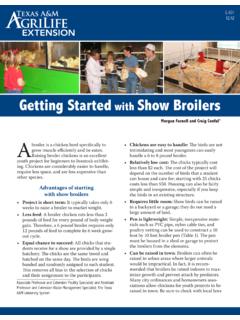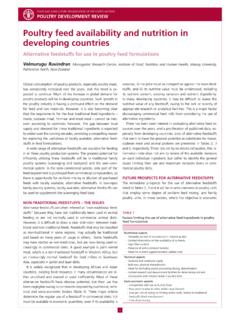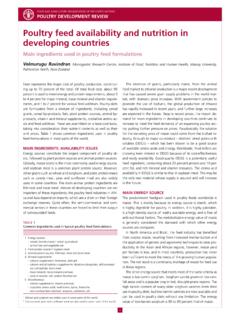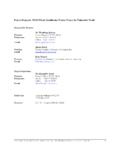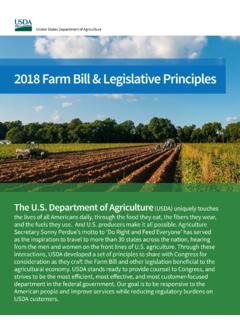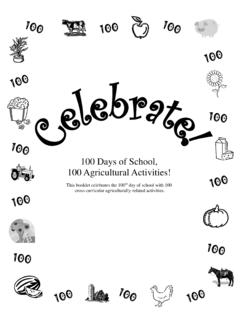Transcription of Nutrition and Feeding of Show Poultry
1 The championship potential of a chicken orturkey is determined by genetics. The animal senvironment dictates whether this championshippotential will be attained. Nutrition is a critical partof a bird s environment, and a good ration isthe foundation of chicken and matter what a bird is fed, nit will only grow as well as you feedit, andnit can not grow beyond its maxi-mal are four important princi-ples in developing an appropriatenutrition program for show broilersand 1: To grow, birdsmust eat and feed stunts development andprevents birds from growing to their poten-tial. Since birds grow quickly, if their feedconsumption decreases for only a fewhours their ultimate body size can besignificantly diminished.
2 Several factors can cause birds to eat less thanthey should. These factors are: feed availability,water availability, feed competition, water competi-tion, environmental temperature and personalattention. Fresh, clean water and feed must be continuous-ly available to birds from the beginning. Order theproper feed from your farm store before your birdsarrive. Make sure birds are able to easily reachwater and feed . During the first week, place feed inflat pans so young birds can easily find and eat chick waterers so that water is easily , as birds grow, hanging tube feeders can beused. These feeders refill the Feeding trough asbirds eat. Keep the height of the feed trough adjust-ed to the birds chest height.
3 Make sure feed isdeep enough in the trough and that access to thefeeder is clear. Provide enough feeder space so thatall birds can eat at the same time without being toocrowded. The bird should be able to eatwithout fear of being pecked by anotherbird or without fear of their combs andbeaks contacting other is a direct relationshipbetween the amount of water a birdconsumes and the amount of feed itwill eat. If the water supply is inade-quate, birds stop also is important. Ifthe room is too warm birds will eatless. So a comfortable temperaturefor the age of the bird should bemaintained. feed quality also affectsconsumption. Birds given stale, rancid ormoldy feed will stop eating.
4 To keep feedfresh, store it properly away from expo-sure to heat, moisture and sunlight(sunlight destroys vitamins).Birds respond to attention. Dragging your fingerthrough the feed in the trough will stimulate themto 2: To grow well, birds musteat the right feed should contain all nutrients needed togrow muscle, bone, internal organs, fat and feath-ers. The following table lists the five basic classes ofnutrients birds need and the feed ingredients thatusually supply and Feeding ofShow PoultryA. Lee CartwrightAssociate Professor and Extension Poultry SpecialistThe Texas A&M University SystemTexas Agricultural Extension Service Zerle L. Carpenter, Director The Texas A&M University System College Station, TexasL-5159 Nutrient primarilyNutrient needed:supplied by:carbohydratescorn, sorghum, other grainsproteins soybean meal, meat products, amino acids(methionine, lysine)fatscorn oil, blended fatproductsmineralssalt, limestone, calcium carbonate, calcium phosphate, trace mineral mixvitaminsvitamin mix, other ingredientsThese ingredients are mixed in different propor-tions and ground into meal.
5 The feed can be baggedas this meal (sometimes called mash ), or the mashcan be pressed into larger pellets or crumbles. Feedbags have tags with information about the mixtureof nutrients supplied by the feed . The tag does notlist the proportion of all ingredients, but it does listthe percentages of several important nutrients thatare good measures of feed quality. An example ofwhat you might see on a show feed tag is illustratedbelow. Notice that some nutrients have minimumlevels while others have maximum protein (CP) ..min 26%Lysine ..min ..min fiber ..max (Ca) ..min ..max (P) ..min ..min ..max , a feed is much more complex than theinformation on the tag can indicate.
6 It containsamino acids, the building blocks of protein, as wellas vitamins, minerals and other nutrients. No onefeed ingredient contains all the nutrients requiredfor a complete diet. Some feed ingredients are richin one nutrient but poor in another. This is the rea-son feed is a mixture of ingredients. For example,soybean meal is rich in protein, while corn is highin energy but a relatively poor source of they complement each other in the ingredient has a place in a balanced fats, vitamins, minerals and amino acidsare so vital for the bird that they are called essen-tial nutrients. Even though the amounts requiredare usually small, birds will sicken or die withoutany one of these essential nutrients.
7 Principle 3: To win, birds must eatand grow in a balanced ration is the amount of food that a bird will eatin a day. Birds will eat this much and no more, soeverything they need must be in this amount offeed. Several balances of ingredients must be main-tained:energy and proteinamino acids (complete protein)minerals essential fats (and fat-soluble vitamins)A chicken or turkey stops eating once a certainamount of energy has been consumed in a bird stops eating even if it has not eatenenough protein, vitamins and minerals. Because fatcontains more than twice the energy contained inprotein or carbohydrate, an increase in the amountof fat in a diet must be balanced with increasedprotein.
8 The energy concentration of the diet mustbe balanced with other nutrients in the contains 20 amino acids that build mus-cle protein. Fourteen of these building blocks mustbe supplied and balanced in the diet. If any one ofthem is missing, or isn t supplied in the properamount, muscle protein can not be made and theremaining amino acids will be used for energy orfat minerals are required in poultrydiets. In a good Poultry ration these minerals arecarefully balanced. Mineral supplements should beadded to a diet only with extreme care, because anexcess of one type of mineral can cause a deficiencyof another mineral. The bones of a growing chickare especially susceptible to mineral deficiency, orimbalance caused by excess should be given in adequate amounts,but some vitamins can be toxic if too much isgiven.
9 Some vitamins even interact detrimentallywith minerals. Excess vitamins are not only expen-sive, but can cause health illustrate the complexity of a complete andbalanced Poultry ration, Tables 1 and 2 list the sci-entifically determined nutrient requirements ofbroiler chickens and turkeys at different ages aspublished in the National Research Council sNutrient Requirements of Poultry . These nutrient con-centrations are the minimalrequirements forgrowth and health. Your show diet will be a dif-ferent formulation, since the National ResearchCouncil s data state minimal for-mulation is a complicated process that ensures afeed contains all the nutrients that a bird training or a computer program arerequired to confidently formulate a Poultry 1.
10 Nutrient requirements of broiler chickens as percentages, milligrams orunits per kilogram of feed for different weeks of age3-6 weeks of age6-8 weeks of ageEnergy in dieta(ME/Kg)kcal3,2003,2003,200 Protein% + Serine% + Cystine% + Tyrosine% acid% , available% AIU1,5001,5001,500 Vitamin DICU200200200 Vitamin EIU101010 Vitamin 0 Vitamin , are typical dietary energy 2. Nutrient requirements of turkeys as percentages, milligrams or units perkilogram of feed for each sex at various and age (in weeks)M: 0-44-88-1212-1616-2020-24 NutrientUnitsF: 0-44-88-1111-1414-1717-20 Energy in dieta(ME/Kg)kcal2,8002,9003,0003,1003,20 03,300 Protein% + Serine% + Cystine% + Tyrosine% acid% , available% AIU4,0004,0004,0004,0004,0004,000 Vitamin DbICU900900900900900900 Vitamin EIU121210101010 Vitamin acidmg11.
